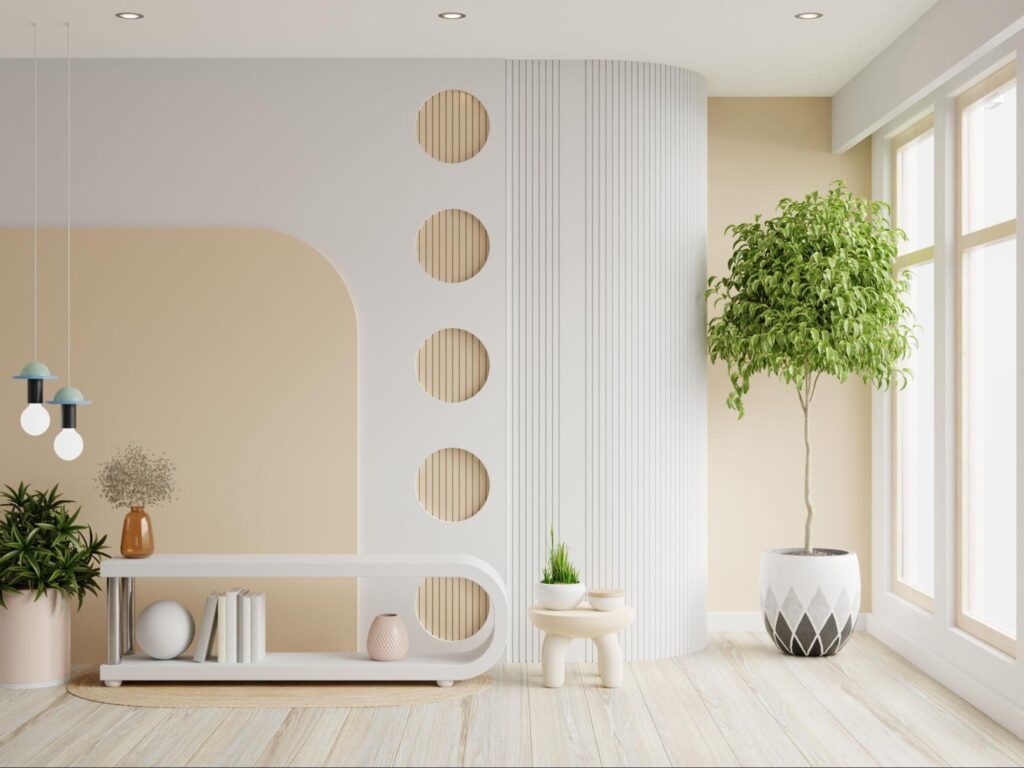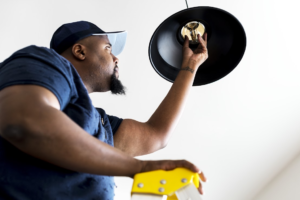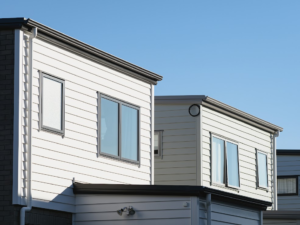Interior trim can transform a home from ordinary to extraordinary. It’s more than just a finishing touch; it defines spaces and adds character. Well-chosen trim creates cohesion between walls, ceilings, and floors. This detail-oriented aspect of home design often goes unnoticed but profoundly impacts the overall aesthetic.
What Is an Interior Trim?
Interior trim is the decorative element that outlines and enhances various parts of a room. These components have evolved from their initial functional roles to crucial design features, adding detail and charm. Historically, interior trim showcased craftsmanship and architectural styles, and today, it plays a vital role in defining the aesthetics of a space.
Types of Interior Trim
Interior trim has various styles and functions, each contributing uniquely to a home’s look and feel. These elements add layers of detail and character, from the protective and decorative baseboards to the elegant crown molding. Understanding the different trim types can help homeowners choose the best options to enhance their home’s aesthetic.
Baseboards
Baseboards are the trim pieces that run along the bottom of the walls. They protect walls from damage and provide a finished look. Depending on the desired aesthetic, baseboards can be simple or elaborate. They connect the walls and floors seamlessly, creating a polished appearance.
Crown Molding
Crown molding sits at the junction of walls and ceilings. It adds a touch of elegance and heightens the perception of ceiling height. The intricate crown molding designs can transform a plain room into a sophisticated space. This trim type is often associated with traditional and luxurious interiors.
Window and Door Casings
Casings frame windows and doors, providing a transition between the walls and these openings. They enhance a home’s architectural style and add depth. Window and door casings can be plain or decorative, aligning with the home’s overall design. These trim elements draw attention to the windows and doors, making them focal points.
Chair Rails and Wainscoting
Chair rails run horizontally along walls, typically at chair height. They protect walls from chair back damage and add visual interest. Wainscoting extends from the floor to the chair rail, often featuring panel designs. These elements break up wall space and add texture and depth.
Impact of Interior Trims on Home Aesthetics
Trim work elevates a home’s design by enhancing architectural styles, creating visual interest, and adding perceived value. Knowing its impact can help homeowners make informed decisions to improve their living spaces.
Enhancing Architectural Style
Trim enhances a home’s architectural style, reinforcing its design language. Whether modern, traditional, or eclectic, trim elements can be tailored to match. For instance, sleek and minimalistic trim complements contemporary homes. In contrast, ornate trim suits classic and Victorian styles.
Creating Visual Interest
Trim adds visual interest by breaking up large wall surfaces. It introduces lines, patterns, and textures that guide the eye. These elements can make a room feel larger, cozier, or more dynamic. Trim also provides opportunities for accent colors, enhancing the room’s overall palette.
Adding Perceived Value
Quality trim work increases a home’s perceived value. It signals attention to detail and high craftsmanship. Homebuyers often appreciate these touches, seeing them as indicators of a well-maintained property. Investing in trim is a strategic move to boost a home’s market appeal.
Material Choices for Interior Trim and Their Effects
The choice of trim material affects both aesthetics and functionality. Each material offers distinct advantages, influencing the final look and durability of the trim work. Homeowners should consider the characteristics of wood, MDF, and PVC when selecting trim for their spaces.
Wood
Wood is a traditional and popular choice for trim. It offers natural beauty and warmth, and it’s versatile in terms of staining and painting. Wood types like oak, pine, and maple provide various aesthetic and functional benefits. Wood trim can be more expensive but offers durability and a classic look.
MDF (Medium Density Fiberboard)
MDF is a cost-effective alternative to wood. It’s smooth and easy to paint, making it a favorite for budget-friendly projects. However, it’s less durable than wood and can swell when exposed to moisture. Despite this, MDF trim is an excellent choice for interior spaces that are not prone to high humidity.
PVC (Polyvinyl Chloride)
PVC trim is known for its moisture resistance and durability. It’s often used in bathrooms and basements where wood might suffer. PVC can be painted and comes in various styles, though it may lack the natural warmth of wood. Its resilience makes it a practical choice for specific applications.
Color and Finish Considerations for Interior Trim
Color and finish for trim define a room’s aesthetic. The interplay of color and finish can enhance or detract from the overall design. Homeowners should consider how different options interact with other spaces’ elements.
Choosing the Right Color
The color of the trim significantly affects a room’s aesthetic. White is a classic choice, offering a clean and timeless look. Darker trim can add drama and sophistication, while bold colors create a statement. The choice should complement the room’s overall color scheme and style.
Effects of Different Finishes
Trim finishes range from matte to high gloss. Matte finishes offer a subtle, understated look, while glossy finishes reflect light and add sheen. The finish can also impact the perception of color and texture. Selecting the right finish enhances the trim’s visual and tactile appeal.
Trends in Trim Colors
Current trends in trim colors include shades beyond the traditional white. Homeowners are experimenting with grays, blues, and even black for a modern touch. These colors can make a room feel contemporary and stylish. Keeping up with trends allows homeowners to refresh their spaces without major renovations.
Maintenance and Longevity of Interior Trim
Proper maintenance of interior trim ensures its longevity and aesthetic appeal. Different materials require specific care routines to maintain their quality.
Caring for Different Materials
Each trim material requires specific care to maintain its appearance and longevity. Wood trim needs regular dusting and occasional polishing. MDF trim should be kept dry to prevent swelling. PVC trim can be cleaned with mild soap and water, making it low-maintenance.
Repair and Replacement Tips
Over time, trim can suffer damage from wear and tear. Minor dents and scratches in wood trim can often be repaired with wood filler and touch-up paint. If severely damaged, MDF and PVC trim might need replacement. Regular inspections help catch issues early, ensuring the trim remains in good condition.
Cost Considerations for Interior Trims
Budgeting for trim involves considering material, style, and installation costs. Wood tends to be pricier than MDF and PVC, but it offers lasting value. Homeowners should also factor in labor costs if hiring professionals. But there are budget-friendly alternatives to typical trim materials. MDF and PVC provide affordable options without sacrificing style. Pre-finished trim can save on printing costs. DIY installation also reduces expenses, making high-impact designs more accessible. Planning and comparing options can help achieve the desired look within budget.
Maximizing Interior Trim Impact
Maximizing the impact of interior trim involves thoughtful design and strategic choices. Combining different types of trim can create a unique and cohesive look. For example, pairing crown molding with baseboards enhances the room’s architectural detail. Mixing materials and styles adds depth and interest. Thoughtful combinations can elevate the design without overwhelming the space.
On the other hand, customization allows homeowners to tailor trim to their tastes. It can include unique profiles, sizes, and colors. Personalization offers the opportunity to create one-of-a-kind designs that reflect personal style. It ensures that the trim fits the space and enhances its character.
Why Hire Professionals for Trim Installation?
Hiring professionals for interior trim installation can significantly impact the quality and outcome of the project. Professional installation offers numerous advantages that ensure a seamless and aesthetically pleasing result.
Precision and Quality
Professional remodelers ensure precision and quality in every aspect of the trim installation. Skilled installers have the experience and expertise to execute complex designs flawlessly. They use specialized tools and techniques that guarantee a perfect fit and finish. This level of craftsmanship is often challenging to achieve with DIY efforts.
Time and Efficiency
Professional installers complete projects more quickly and efficiently than most DIY approaches; their familiarity with the process allows them to work swiftly without compromising quality. This efficiency minimizes disruption to the household, making the renovation process smoother and faster. Homeowners can enjoy their newly trimmed spaces sooner.
Handling Complex Designs
Complex trim designs, such as intricate crown molding or custom-built casings, require advanced skills. Professionals are adept at managing these complexities, ensuring every detail is meticulously crafted. They can also offer creative solutions and suggestions that enhance the overall design. This expertise results in a more sophisticated and cohesive look.
Access to Quality Materials
Professionals often have access to high-quality materials that need to be more readily available to the general public. They can recommend the best options for durability and aesthetics, ensuring long-lasting and beautiful trim work. Additionally, they might partner with suppliers, allowing them to source better-quality materials.
Problem Solving and Adaptability
Remodeling projects can present unexpected challenges, such as uneven walls or unforeseen structural issues. Professionals are equipped to handle these problems efficiently. Their experience enables them to adapt and find solutions that maintain the integrity and appearance of the trim work. This adaptability ensures that the project stays on track and meets the homeowner’s expectations.
Warranty and Accountability
Professional trim installers often provide warranties for their work, offering homeowners peace of mind. This warranty ensures that any issues arising from the installation will be addressed promptly and at no additional cost. Professionals are also accountable for their work, ensuring that the final result meets the agreed-upon standards and specifications.
Cost-Effectiveness in the Long Run
While hiring professionals may seem more expensive upfront, it can be cost-effective in the long run. Professional installation reduces the likelihood of mistakes and the need for costly repairs. The high-quality artistry adds value to the home, making it a worthwhile investment. Additionally, professionals can prevent waste by accurately measuring and cutting materials, further optimizing costs.
Safety and Compliance
Installing trim involves using tools and techniques that can pose safety risks. Professionals are trained to handle these tools safely, reducing the risk of accidents. They also ensure that the installation complies with local building codes and regulations, which is crucial for maintaining the home’s safety standards.
A Stress-Free Experience
One of the most significant benefits of hiring professionals is the stress-free experience it provides. Homeowners can relax, knowing that their project is in capable hands. Professionals manage the entire process, from planning and preparation to execution and cleanup. This comprehensive service allows homeowners to focus on enjoying the transformation of their spaces.
Elevating Home Aesthetics With Professional Trim Installation
The advantages of hiring professionals for interior trim installation are manifold, encompassing precision, efficiency, and high-quality results. By leveraging professional expertise, homeowners can ensure their trim projects enhance the beauty and value of their homes. Investing in professional installation guarantees a flawless finish and provides peace of mind, making it a prudent choice for those seeking to elevate their home aesthetics.
Explore detailed articles and expert advice on our Build All Construction blog.







